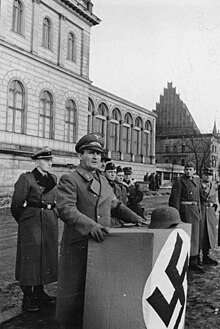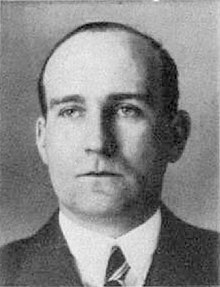Karl Hanke

Karl August Hanke (born August 24, 1903 in Lauban , † probably June 8, 1945 in Neudorf an der Popelka ) was a functionary of the NSDAP during the Nazi era . Karl Hanke was the last Reichsführer SS .
Life
A trained master miller by profession , Hanke had been a trade teacher in Berlin since 1928 after visiting a mill construction technical center . In 1931 he was dismissed from the Prussian civil service because of his work in the NSDAP, of which he had been a member since May 1, 1928 ( membership number 102.606) . After the success of the NSDAP in the Reichstag election of September 14, 1930 , he became head of the NSDAP district leadership West in Berlin and gave the young architect and NSKK man Albert Speer his first order to convert a villa in Berlin-Grunewald into the district organization's quarter . Also from 1930 Hanke was a member of the SA reserve .
Since the state elections on April 24, 1932, Hanke sat in the Prussian state parliament ; in the same year he was also elected as a member of the Reichstag . From April 1, 1932, he was the personal adjutant of the Berlin Gauleiter Joseph Goebbels . As such, on the instructions of Goebbels, he also commissioned Albert Speer to build a new official seat for the Gauleitung of the Berlin NSDAP at Vossstrasse 11 in the Berlin government district .
After the Reichstag elections in 1933 and the establishment of the Reich Ministry for Public Enlightenment and Propaganda on March 13, 1933, Hanke also acted in the ministry as a personal advisor to the minister and at the same time as head of Goebbels' private secretariat. On June 27, 1933, he was appointed Ministerial Councilor, and on April 20, 1937, Hanke was appointed Ministerial Director. After Walther Funk was appointed Reich Economics Minister in 1938, Hanke succeeded him as State Secretary in the Reich Ministry for Public Enlightenment and Propaganda.
On February 15, 1934, Hanke joined the General SS (SS no. 203.103). From 1937 he was a leader in the command staff Reichsführer SS of Heinrich Himmler .
The apparently unstoppable rise of Hanke in the slipstream of the Reich Propaganda Minister came to a rapid end when Hanke was drawn into the personal involvement of the Goebbels. Goebbels, famous and notorious for his numerous extramarital affairs, mainly with actresses, tied up with the Czech Lída Baarová in 1937/38 . The marriage to Magda Goebbels seemed to be over. Hanke took the side of the wife with whom he had a semi-familiar relationship. Apparently, Magda Goebbels, who was two years her senior, was temporarily ready to leave her eternally unfaithful husband for Hanke. Both affairs were ended by Hitler in 1939 with a word of power.
Hanke volunteered for the Wehrmacht in the summer of 1939 . With the 3rd Panzer Division he took part in the attack on Poland at the beginning of the Second World War. In 1940 he fought as a front soldier and orderly officer in the 7th Panzer Division under Rommel in the western campaign . He received the Iron Cross 1st and 2nd class and the tank battle badge in silver for his service . At the beginning of 1941 he was discharged from the Wehrmacht as a first lieutenant.
Thereupon, on February 9, 1941, Hanke was appointed by Hitler as Oberpräsident and Gauleiter of Lower Silesia . During Hanke's tenure, over a thousand people were executed in Breslau, which earned him the nickname "Executioner of Breslau". Hanke was close friends with Otto Fitzner , who worked as a mine director for Giesche's heirs in Katowice (company headquarters in Breslau); Historians suspect that information about the approaching Holocaust reached Eduard Schulte very early on . In 1942 he succeeded in sending various bundled information about the mass gassings to the Allies ( Riegner telegram ). On January 30, 1944, Hanke was appointed SS-Obergruppenführer .
As combat commander, he headed the defense of the city of Wroclaw, which was declared a fortress, from January 23, 1945 . As early as January 27, 1945, he had the mayor of the city, Wolfgang Spielhagen , who he did not like, arrested for allegedly preparing to flee, and the following day he had the court shot. While Hanke "[...] celebrated his provincial variant of the forced suicide of a city" at the expense of the civilian population , Goebbels finally paid tribute and respect to the former rival. On April 3, 1945 he noted in his diary: “Hanke received extraordinary praise from the Fuehrer at the briefing. He deserves it too. Among our fighting Gauleitungen he is the outstanding leader nature. He is also militantly involved in a way that unfortunately cannot be established with the other Gauleiter. ”On April 12, 1945, Hanke received the German Order . Impressed by his unconditional obedience, Hitler named him in his political will on April 29, 1945 as the successor to Heinrich Himmler, who had since fallen out of favor, as Reichsführer SS and chief of the German police.
When Breslau surrendered on May 6th, Hanke could no longer be found; he had probably fled the besieged city immediately beforehand with a Fieseler Storch that had been kept ready . Apparently he joined the 18th SS Volunteer Panzer Grenadier Division "Horst Wessel" in Prague . After fighting with Czech partisans, the latter surrendered near Neudorf (Nová Ves). After temporary imprisonment, Hanke was probably shot and killed by Czech guards while attempting to escape from a transport of German prisoners of war . Other reports said he was brought to Poland and executed there. In contrast, Wilfred von Oven , Goebbels' former advisor, claims to have seen Hanke in Argentina after 1945 .
TV shows
- The executioner of Wroclaw. Lower Silesia Gauleiter Karl Hanke. A film by Ernst-Michael Brandt, MDR 2005, 45 minutes
literature
- Volker Ullrich : Eight days in May. The last week of the Third Reich. CH Beck, Munich 2020, ISBN 978 3 406 74985 8 , pp. 30, 183-188.
- Antony Beevor : Berlin 1945. The end. Goldmann, Munich 2005, ISBN 3-442-15313-1 .
- Martin Moll: The fall of old fighters. A new approach to the rule analysis of the Nazi regime. In: Historical communications from the Ranke Society. Vol. 5, 1992, ISSN 0939-5385 , pp. 1-51.
- Jana Richter: Karl Hanke. In: Hermann Weiss (Ed.): Biographical Lexicon for the Third Reich . S. Fischer, Frankfurt am Main 1998, pp. 177f.
- Gitta Sereny : Albert Speer. His struggle with the truth. Goldmann, Munich 2005, ISBN 3-442-15328-X .
- Albert Speer : Memories. Propylaen Verlag, Frankfurt am Main et al. 1969.
Web links
- Literature by and about Karl Hanke in the catalog of the German National Library
- Karl Hanke in the database of members of the Reichstag
- Karl Hanke in the online version of the Reich Chancellery Edition Files. Weimar Republic
- Short biography - project "Officials of National Socialist Reich Ministries"
Individual evidence
- ↑ a b c d e f g h Karl Hanke . In: Officials of National Socialist Reich Ministries . February 6, 2018 ( ns-reichsministerien.de [accessed March 29, 2018]).
- ^ Michael Miller Leaders of the SS and German Police . Vol. 2. R. James Bender, San Jose CA 2015, ISBN 978-1-932970-25-8 , pp. 15, 17.
- ^ Ernst Klee : Das Personenlexikon zum Third Reich , Frankfurt am Main 2007
- ^ Samuel W. Mitcham: Rommel's Lieutenants: The Men Who Served the Desert Fox 2007, Greenwood Publishing Group ISBN 0-275-99185-7 .
- ^ Beevor: Berlin 1945. 2005, p. 375.
- ↑ a b Gordon Williamson: The SS - Hitler's instrument of power. Neuer Kaiser Verlag, Fränkisch-Crumbach 1998, ISBN 978-3-8468-2003-2 .
| personal data | |
|---|---|
| SURNAME | Hanke, Karl |
| ALTERNATIVE NAMES | Hanke, Karl August (full name) |
| BRIEF DESCRIPTION | German politician (NSDAP), MdR, party functionary during the time of National Socialism |
| DATE OF BIRTH | August 24, 1903 |
| PLACE OF BIRTH | Lauban |
| DATE OF DEATH | uncertain: June 8, 1945 |
| Place of death | Neudorf an der Popelka |

